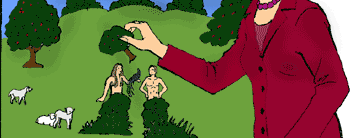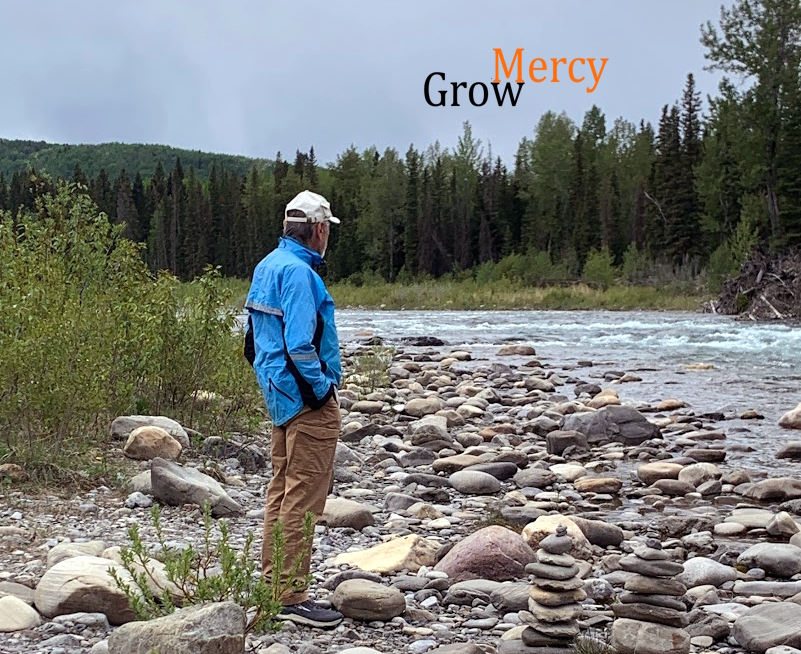The earliest stories I remember hearing were in Sunday School, read from the first book of the Old Testament. The language sounded odd, elevated; and what our blossoming minds couldn’t understand of the language was aided by small cloth figures that moved from place to place on a flannelgraph.
My memory could be faulty here, but the first story I recall, appropriately I suppose, was the story of how we got here. Or what our Baptist pastor, who preached upstairs in the sanctuary, called the Origin of Man.
Downstairs, in Sunday School, Mrs. Pahl primed our imaginations with the story: Adam and Eve, two "real people" who found themselves, quite unexpectedly you would think, in a garden and the only couple on the earth—naked to boot.
The flannelboard was bedecked by spreading trees and ferns such as nothing I’d seen in Saskatchewan. However, the cloth cut-out of Eve, due to the length of Eve’s hair and the surrounding foliage, was disappointing. But perhaps I’m remembering an adolescent take on that. For at the time, barely into Kindergarten, the picture would have flushed out a few giggles.
As it happened, the man was created first. (Trees had already been created because there was one he was warned away from. Apparently a certain kind of knowledge was a bad thing, best to leave some kinds of knowing to God.)
Now God saw that it wasn’t good for Adam to be alone so he made all the "beasts of the field" and got Adam to give them names. This, according to the pastor upstairs, was an important bit of information because, naming, by the man, "was an act of dominion."
But even with all these animals, there was still no suitable helper. I think we found this difficult to believe. Surely among the bunch there would have been a pinto, or a friendly collie.
Our teacher read on: "So the Lord God caused a deep sleep to fall upon the man, and he slept." Now while Adam was in a God-induced coma, God took out one of his ribs, closed him back up, and carved a woman. Then God woke him up and showed him his new creation. And the man said, “This is now bone of my bones, And flesh of my flesh," which is a beautiful line of poetry and taken as that, a moment of lucid rapturous equality.
The preacher upstairs, at this point of the story, would pull from the archives a quote from the go-to theologian Matthew Henry: "The woman was made of a rib out of the side of Adam; not made out of his head to rule over him, nor out of his feet to be trampled upon by him, but out of his side to be equal with him, under his arm to be protected, and near his heart to be beloved.”
And how seemly it sounded. Adam, his new partner/helper, an equal along side of him. Meanwhile, downstairs in Sunday School, where Mrs. Pahl taught, and upstairs in the sanctuary where Reverend Pahl preached, the story concluded with the immutable fact, that this new her-for-him shall be called Woman, because she was taken out of man."
Upstairs, where a succession of men preached, we came to understand what theological equality entailed. How God forever ordained not only reproductive roles but roles of authority and position. And always, one heard the undertone of how this woman-fashioned-from-man was a copy, a by-product, tailings of the excellent original.
And so it would go. The men would teach and preach upstairs, and always ingratiatingly remember to announce—in referencing potlucks to Sunday School teaching—Oh the women, God bless ’em.
This was the received model. And it worked within the dominant story. I should say, is still "working" within many of the largest denominations in Christendom. Of course how this "original blueprint" gets worked out in the church, in church families, has not always been pretty. At times it’s been ugly.
Gratefully, good things have come through courageous women. And the questioning of the old frame will, and must, continue until flesh of our flesh and bone of our bone means simply and profoundly that.
So, to that dream, let me share what I think is a far finer expression of that old story. It’s from Lorna Crozier’s poem Myth, from the book, The Garden Going on Without Us.
I was not made from a thin, dry rib
white and bare as if chewed and sucked
by a small dog. These breasts did not come
from a man’s side, this round belly, this
hollow at the centre. We dreamed each other
at the same time and we dreamed a garden.
When we awoke there was wind in the leaves
above us apples glowing like red moons
as we turned to one another in the sweet green air.

It is refreshing to shift the gaze in this origin story from the apple to original blessing. Viva la difference in all her natural beauty as expressed by quote from Lorna Crozier.
Thanks Ray. My thoughts exactly.
Thanks, Steve. I expect this issue is going to come to a head at some point in the church I serve. I believe that the hermeneutical starting point needs to be, not Gen. 2, bu Gen. 1 – God created them in his image, male and female, in his image. This is to be supplemented by the quote in Galatians 3:28 – “there is therefore now no longer slave or free, Jew or Gentile, male and female, for we are all one in Christ.”, and Acts 2 where the Holy Spirit falls on all, men and women. With this starting point, the other parts will be seen in a different light too.
I loved the piece from Lorna Crozier.
Thanks Sam, appreciate your thought here. I’ll be interested to know how the conversation in your church goes.